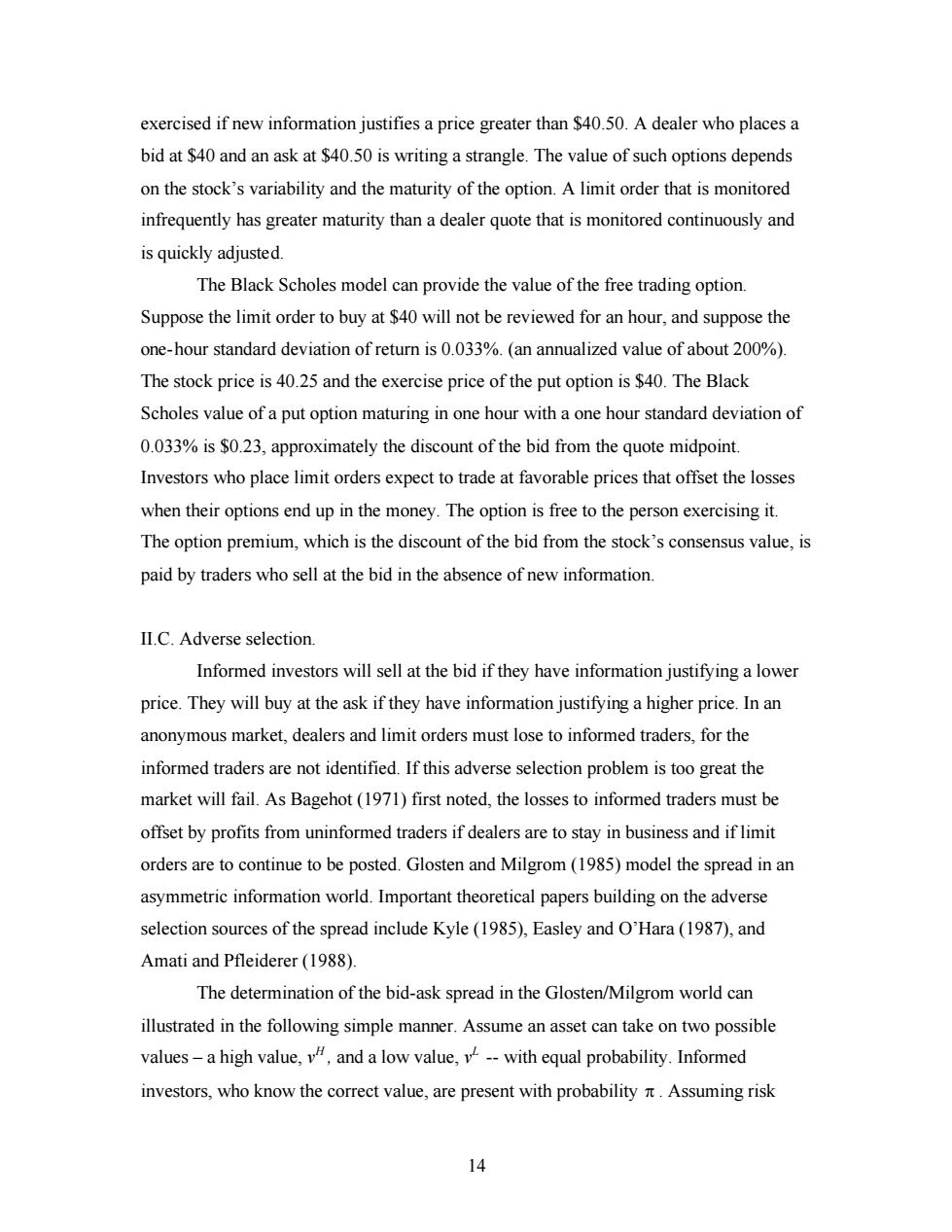正在加载图片...

exercised if new information justifies a price greater than $40.50.A dealer who places a bid at $40 and an ask at $40.50 is writing a strangle.The value of such options depends on the stock's variability and the maturity of the option.A limit order that is monitored infrequently has greater maturity than a dealer quote that is monitored continuously and is quickly adjusted. The Black Scholes model can provide the value of the free trading option. Suppose the limit order to buy at $40 will not be reviewed for an hour,and suppose the one-hour standard deviation of return is 0.033%.(an annualized value of about 200%). The stock price is 40.25 and the exercise price of the put option is $40.The Black Scholes value of a put option maturing in one hour with a one hour standard deviation of 0.033%is $0.23,approximately the discount of the bid from the quote midpoint. Investors who place limit orders expect to trade at favorable prices that offset the losses when their options end up in the money.The option is free to the person exercising it. The option premium,which is the discount of the bid from the stock's consensus value,is paid by traders who sell at the bid in the absence of new information. II.C.Adverse selection. Informed investors will sell at the bid if they have information justifying a lower price.They will buy at the ask if they have information justifying a higher price.In an anonymous market,dealers and limit orders must lose to informed traders,for the informed traders are not identified.If this adverse selection problem is too great the market will fail.As Bagehot(1971)first noted,the losses to informed traders must be offset by profits from uninformed traders if dealers are to stay in business and if limit orders are to continue to be posted.Glosten and Milgrom(1985)model the spread in an asymmetric information world.Important theoretical papers building on the adverse selection sources of the spread include Kyle (1985),Easley and O'Hara(1987),and Amati and Pfleiderer(1988). The determination of the bid-ask spread in the Glosten/Milgrom world can illustrated in the following simple manner.Assume an asset can take on two possible values-a high value,,and a low value,-with equal probability.Informed investors,who know the correct value,are present with probability nt.Assuming risk 1414 exercised if new information justifies a price greater than $40.50. A dealer who places a bid at $40 and an ask at $40.50 is writing a strangle. The value of such options depends on the stock’s variability and the maturity of the option. A limit order that is monitored infrequently has greater maturity than a dealer quote that is monitored continuously and is quickly adjusted. The Black Scholes model can provide the value of the free trading option. Suppose the limit order to buy at $40 will not be reviewed for an hour, and suppose the one-hour standard deviation of return is 0.033%. (an annualized value of about 200%). The stock price is 40.25 and the exercise price of the put option is $40. The Black Scholes value of a put option maturing in one hour with a one hour standard deviation of 0.033% is $0.23, approximately the discount of the bid from the quote midpoint. Investors who place limit orders expect to trade at favorable prices that offset the losses when their options end up in the money. The option is free to the person exercising it. The option premium, which is the discount of the bid from the stock’s consensus value, is paid by traders who sell at the bid in the absence of new information. II.C. Adverse selection. Informed investors will sell at the bid if they have information justifying a lower price. They will buy at the ask if they have information justifying a higher price. In an anonymous market, dealers and limit orders must lose to informed traders, for the informed traders are not identified. If this adverse selection problem is too great the market will fail. As Bagehot (1971) first noted, the losses to informed traders must be offset by profits from uninformed traders if dealers are to stay in business and if limit orders are to continue to be posted. Glosten and Milgrom (1985) model the spread in an asymmetric information world. Important theoretical papers building on the adverse selection sources of the spread include Kyle (1985), Easley and O’Hara (1987), and Amati and Pfleiderer (1988). The determination of the bid-ask spread in the Glosten/Milgrom world can illustrated in the following simple manner. Assume an asset can take on two possible values – a high value, v H , and a low value, v L -- with equal probability. Informed investors, who know the correct value, are present with probability p . Assuming risk